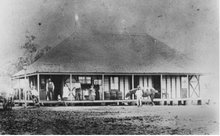The hero of Blithe Girl’s latest library book is Charlie Bone whose claim to fame is that he can talk to people in photographs. I think that this would be very useful. I’ve been scanning photos on the Picture Queensland website trying to get a sense of what life was like for early settlers. It’s always a challenge to find the right search term. I’ve found that a common useful label is “country life.” Using this tag has brought up many pictures of early farmers, farmhouses and rural communities.
I was distracted for a time yesterday by thinking about how fashions have changed in family photography. So many historical portraits picture unsmiling, even grim faces. I think it was partly the cost of such studio portraits and also the novelty. You didn’t want to waste time and money looking goofy. And it was such an unusual occurrence that people were rendered solemn. It also seemed to be the photographer’s preference, perhaps because getting everyone to look serious meant that you had to take fewer frames. I generally don’t like just economic rationales for things, but it could have been simple economy on the part of the photographer. I remember taking Santa photos in David Jones as a uni student. Parents expected children to all look happy in the photos (if not immediately before and after) and you can imagine how difficult it could be to make everyone look suitably festive at the same time. Many frames of film were wasted in the pursuit of jollity. At least with contemporary digital cameras wastage of everything except time is less of an issue.
Of especial interest to me are the wedding photos. In the archives that I scanned, it wasn’t until 1953 that the “happy couple” were actually portrayed as such. Earlier wedding portraits showed an array of solemnity enough to turn one off the institution of marriage. And yet I am sure that it was the result of portraiture and its expectations rather than a reflection on marriage.
Archived photographs from the 1920s show photography as becoming more informal and more a record of everyday life. There are photos of families having picnics at the beach: the men tieless and with trousers rolled up, the women heavily hatted with even a few hiked skirts and the children happily barefoot. Then in the ‘40s and ‘50s there start to be collections of happy family snaps: of children sailing with their parents, playing outside, adolescents dancing and images of people working. I just wish that I could talk to these photos. Maybe I’ll have to find out how Charlie does it.
Subscribe to:
Post Comments (Atom)

1 comment:
Aside from the cost and the novelty of it, I thought that early photos required long exposures (certainly daguerreotypes did) -- so a smile was too fleeting, and would result in a blur for a mouth. So people were told to be serious and hold still.
I don't think that would apply for the 1920's and later (I think technology had improved by then) -- if people are somber then, perhaps the custom had already been set to be sober in a photo.
My mother always thought it might have something to do with bad teeth, too. A sober look kept the mouth shut on toothless gums.
Boy-child loved the whole Charley Bone series and read it twice last year. One of his very few reading obsessions.
Post a Comment